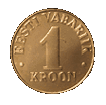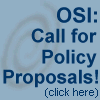Estonia, the smallest of the East European countries seeking to join the European Union, has undergone the swiftest, most comprehensive transformation of a national economy in modern times. It is the nearest thing to Hong Kong in terms of free trade. How did this happen? Will EU membership make any difference?
Estonia's independence from the Soviet Union in 1991 unleashed a tidal wave of reforms: early price liberalisation, a DEM-backed currency board, full currency convertibility, a balanced budget required by law, large-scale privatisation targeting strategic foreign investors, a flat 26 per cent income tax, zero corporation tax and strong bankruptcy laws.
Near-total trade-and-investment liberalisation was critical to the overall reform effort. Unlike other East European countries, Estonia abolished all tariff and non-tariff barriers to trade. It also opened the door fully to foreign direct investment, not least by ensuring that foreign and domestic investors were treated equally under national law.
Such thoroughgoing reforms have delivered impressive results. The economy has grown vigorously since 1995, inflation is under control, and the budget is in balance. Most striking is Estonia's speedy integration into the world economy; Western Europe accounts for two-thirds of its trade, compared to less than one per cent in 1990.
What lies behind such a transformation
 |
| Estonian kroon |
Also important from a political economy angle are crucial institutional and political factors. Within the central government departments – the Bank of Estonia, the Ministry of Finance and the Ministry of Foreign Affairs – technocrats enjoying wide autonomy pushed through core reforms. Successive governments since independence have supported policies initiated and implemented by technocrats within government.
Furthermore, the speed and depth of policy reform, particularly under the government led by Mart Laar between 1992 and 1995, effectively neutralised interest group opposition, including lobbying for agricultural protection. Consequently, by the mid 1990s, and despite changes of government, a firm pro-reform political consensus had been established.
Ideas and personalities also played their part. A small, cohesive group of young politicians, technocrats and entrepreneurs, untainted by the Communist past and acting out of a mixture of pragmatic and ideological considerations, have spearheaded Estonian transition. Early on, a "home-grown" neoliberal ideological consensus coalesced around the set of policies to transform Estonia from Plan to Market, which correspondingly lessened the reliance on policy advice from the international financial institutions.
Ingredients of policy reform in Estonia's Baltic neighbours - Latvia and Lithuania - and even in the "headline" reforming countries in Central Europe, have differed in important respects from the Estonian experience.
| Travelling to Estonia soon? Choose Hotels Central at HotelsEstonia.com to reserve a hotel online at a great price. |
Elsewhere in Eastern Europe, compared to Estonia, technocratic autonomy has been cramped by greater political interference, politics itself has been more conflictual, interest group rent-seeking activity has been more rampant, particularly in agriculture, and a less solid home-brewed ideological consensus on reform has led to greater reliance on policy advice and assistance from abroad, especially from the International Monetary Fund. For all these reasons, Estonia has outpaced its neighbours in policy reform, especially in its commitment to free trade.
Let us shift from the general political economy determinants of policy reform to trade policy in particular. Estonian trade policy since independence has proceeded along four tracks: unilateral, bilateral, regional and multilateral.
The key trade and foreign investment reforms were undertaken unilaterally, i.e. not through international negotiations. However, virtually from the outset, the Ministry of Foreign Affairs signed bilateral free trade agreements with Estonia’s major trading partners. There were two purposes in mind: to secure export market access, and to insure against a reversal of the domestic policy of unilateral free trade.
Since 1994-95, the multilateral track has assumed greater importance in trade policy with Estonia's negotiations to accede to the World Trade Organisation. It finally became a WTO member in November 1999. The WTO provides Estonia with legally binding rights of access to other members' markets, and it constitutes a long-run lock-in mechanism for its national policy of maintaining open markets.
In the second half of the 1990s, the regional track has moved centre-stage in Estonian trade policy. Since 1997, Estonia has been one of six "fast-track" candidates for EU membership.
In general terms, integration with the EU's Single Market will remove existing non-tariff barriers to trade
 |
| Tallinn's Estonia theatre |
Nowhere is the downside of EU membership more apparent than in trade policy. On balance, the other applicants, with protection above the EU average, will lower their barriers to third country imports when they join the EU [although not in agriculture]. For Estonia, in contrast, joining the EU will increase net protection against third countries.
First, Estonia will have to erect a vast wall of common external tariffs against non-EU countries, starting this year, jumping from last year's baseline of zero to a total of 10,794 different tariffs. This will result in serious distortions, and will particularly increase the cost of food.
Second, upon accession Estonia will have to introduce a panoply of EU non-tariff barriers [e.g. subsidies, quotas and anti-dumping duties] that will divert imports from low-cost locations outside the EU to high-cost locations within it. In particular, imports of coal and steel will become more expensive.
This is but a preliminary checklist, but it does show that the EU's entry-ticket is not cheap.

|
The Estonian Miracle stands out as a shining example of classical liberal policy reform in the twentieth century. Like Britain in the 19th century and Hong Kong in recent times, Estonia has embedded sound money, balanced budgets, free trade and a wide open door to foreign investment, in a constitutional package of small government, free markets and light, clear and straightforward regulation. Estonia is the benchmark of policy reform in Eastern Europe, and it compares very favourably to other benchmarks, such as Chile in Latin America and New Zealand in Asia-Pacific.
Although EU membership does hold out the prospect of some political and economic gains, it will inevitably take the shine off a free market orientation in Estonia. With the introduction of customs tariffs this year, Estonian free trade has effectively come to an end. Regulation will inexorably become more opaque and costly on the road to EU membership. Those of a classical liberal disposition will, therefore, allow themselves a Proustian moment to shed a tear in remembrance of things past.
Razeen Sally, 3 July 2000
The Author:
Dr Razeen Sally is Lecturer in International Political Economy at the London School of Economics and Political Science.
This article is reprinted with courtesy from the
Neue Zürcher Zeitung.
Photos courtesy of the Bank of Estonia
Milestones in Estonian policy reform
1990: Price liberalisation; abolition of state trading monopoly.
1991: Independence from the Soviet Union; small-scale privatisation started; first wave of trade liberalisation; law on foreign investment enacted.
1992: New DEM-pegged currency board; new centre-right reformist government led by Mart Laar; large-scale privatisation started; bankruptcy law enacted.
1993: Establishment of Estonian Privatisation Agency on the Treuhand model; abolition of remaining tariffs.
1994: Completion of small-scale privatisation; full current account convertibility according to IMF Article VIII; full capital account convertibility; removal of remaining non-tariff trade barriers; introduction of flat tax.
1995: Economy starts to grow after 36 per cent contraction between 1990 and 1994; start of WTO accession negotiations; Association Agreement with the EU; application for EU membership; start of Baltic Free Trade Agreement; first state-owned bank privatised; commercial code enacted; Laar government voted out of office.
1996: Free Trade Agreement with Ukraine.
1997: 11.4 per cent GDP growth – the highest in Europe; European Commission recommends Estonia as one of six candidates on fast-track to EU membership; free trade agreements with EFTA and Slovenia.
1998: Free trade agreements with Czech and Slovak Republics; commencement of EU accession negotiations; pension reform law adopted; EU-compatible competition law adopted.
1999: Mart Laar leads three party centre-right coalition back to government; Estonia becomes 135th WTO member; law on introducing customs tariffs adopted.
2000: Customs tariffs on agriculture introduced. Tariffs due to go up to WTO bindings by 2001, and then up to EU levels upon accession.
Moving on:
- Read more about Estonia in this issue
- Buy English-language books on the Baltics through CER
- Return to CER front page




